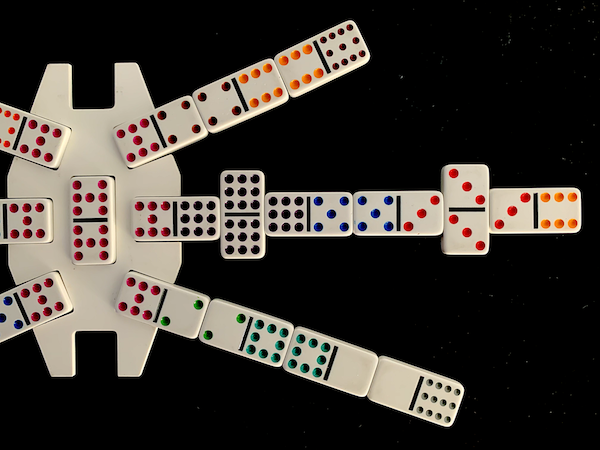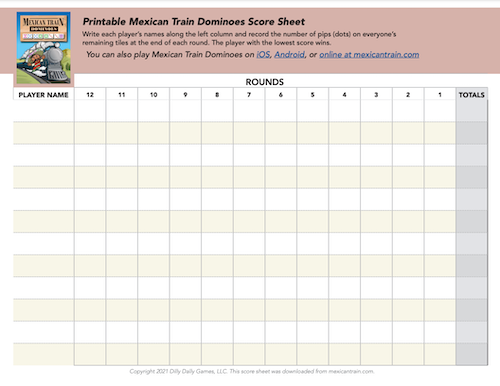Mexican Train Rules and beginner’s guide
These rules follow the most common gameplay. Practice or play against a computer with our iOS, Android, or online Mexican Train Dominoes games.
You will need
- A double-12 domino set
- A marker for each player plus the Mexican Train, such as a quarter.
Objective and Basics
The objective of Mexican Train Dominoes is to be the first player to get rid of all their dominoes by creating trains that connect to the central “hub” or engine.The game is played with a standard set of Double Twelve dominoes, and each player has their own train, as well as the option to play on the Mexican Train, which is a shared train that belongs to all players.
You’ll need a little luck and strategy, as players have to think ahead to create the best possible train while also blocking their opponents.
Get started
Turn all of your dominoes facedown and shuffle them on the table. Each player draws 1 tile. Whoever has the highest pip-count (dots) goes first. Return the tiles facedown and shuffle.Each player should draw dominoes as follows:
- If 2-4 players, draw 15 dominoes
- If 5-6 players, draw 12 dominoes
- If 7-8 players, draw 11 dominoes
Stand your dominoes on edge facing you so they’re not visible to your opponents. The remaining dominoes become the “boneyard”. Play moves clockwise.
Your objective is to play all your dominoes and earn the lowest score across 3 rounds.
Placing dominoes and playing doubles
Dominoes must play end-to-end and match.
Doubles are any tile that show the same number of pips on each side. Playing a double grants you another turn, but must be “closed” by playing another tile on them before you can play anywhere else.
If you can’t close the double, draw 1 tile from the boneyard. If you can close it, do so. If not, play moves to the next player. This process repeats until the double is closed.
Exceptions to doubles:
- It is the last domino of its number or the last domino of the game.
- You played it to remove the marker from your train.
Start by setting the station number
Player 1 starts the public Mexican Train by placing their highest double in the center to set the station number. For instance, playing a double-6 means the station starts at 6.If Player 1 does not have a double, play moves clockwise to the next player. If no one has a double, go around again drawing 1 tile from the boneyard until someone does.
Each player’s first move and opening private trains
Once a player opens the public Mexican Train, each player begins their own private train of dominoes by laying a tile that matches the station number. In our example starting at 6, a player must match the 6.If a player cannot start their train, draw 1 tile from the boneyard. If you still can’t play, place a marker, such as a quarter or other coin, at the end where your tile should be. Play repeats and moves to the next player clockwise.
Starting the Mexican Train
The public Mexican Train begins on an empty line that matches the station number (i.e., 6) in the center or shared between players. It is open to every player and can be started any time after the first round of turns.Next moves and plays
On each following turn, one domino is played per turn unless a double is played, allowing for two turns.On your next turn you can:
- Play on your own private train. If a marker is on your train, you can remove it once you have played on your own train.
- Play on the public Mexican Train.
- Play on another player’s private train only if they have a marker on it.
If you can’t make a move, draw 1 tile from the boneyard. Each player must place a tile on each move or else place a marker indicating their train is open. If the train is already marked, leave it marked.
Managing your remaining tiles is crucial for scoring at the end of the round.
Managing Remaining Dominoes
As the game progresses, you’ll need to manage your remaining dominoes carefully.If a player is unable to play a domino, they must draw a tile from the boneyard and play it if possible. If they still cannot play, they must place a marker on their train to indicate that it is eligible for other players to play on.
Players can also choose to play on the Mexican Train, which can be a powerful tool for getting rid of dominoes quickly. However, players must be careful not to leave themselves with no playable tiles, as this can quickly lead to a loss as you repeatedly draw dominoes.
Scoring
The game ends when the first player runs out of dominoes and grants them a score of 0. All other plays add up the number of pips (dots) on their remaining dominoes.Reset and play two more rounds. The person with the lowest score after all three rounds wins.
Strategy and Tips
To win at Mexican Train Dominoes, players need to develop a strategy that balances the need to play tiles from their hand with the need to block their opponents. Here are some tips to help players improve their game:- Pay attention to the tiles that have been played to anticipate your opponents’ moves.
- Try to create a diverse train with a mix of numbers to increase your chances of playing tiles. Don’t limit yourself to playing only 1s or 2s.
- Use the Mexican Train to your advantage by playing on it when possible, but be careful not to leave yourself with no playable tiles.
- Block your opponents by playing tiles that will limit their options.
- Adapt your strategy as the game unfolds, taking into account the tiles that have been played and the remaining dominoes in your hand.
Frequently asked questions and variations
Here are some common questions and variations that players may encounter:- What happens if a player has only one tile left in their hand?
They must announce “uno” or double-tap the table with two fingers to signal to the other players. - Can a player play on the Mexican Train if they have only one tile left in their hand?
Yes, they can play on the Mexican Train, but they must announce “only one tile” first. - What happens if a player is unable to play a tile and the boneyard is empty?
They must pass and place a marker on their train. - Can a player play a double tile on their own train?
Yes, they can play a double tile on their own train, but they must announce “double” to alert the other players. - Are there any variations of Mexican Train Dominoes?
Yes, there are several variations, including the popular Chicken Foot.

|
You may also be interested in these helpful posts:
- Rules to play Mexican Train dominoes with double six and double fifteen dominoes
- Ready to start playing? Check out these great opening move strategies

